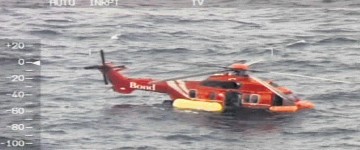
Is it time for a rethink?
When I learned that yet another helicopter had ditched in the North Sea I cringed.
My experience of this sort of thing goes right back to the period from January 1983 to June 1985 when I served with HM Coastguard at the Aberdeen maritime rescue co-ordination centre.
It is a period in my life that I cherish as it provided an insight into North Sea safety that few ever get – rigs and platforms and the support vessels and helicopters which provide lifelines and bus services. And it was before Piper Alpha.
Having, since late 1989 travelled offshore in my role as an energy writer with the Press and Journal on a number of occasions, I can vouch for just how uncomfortable an experience it is, especially with the collar of the ubiquitous survival suit gripping one’s neck a tad too tightly, and the pilot’s musical selection of the day lulling one as the aircraft drones on its journey.
But I’ve done it only a few times; unlike the guys on the Eurocopter aircraft which ditched yesterday, the second this year and the fourth incident in less than four years.
All were what are colloquially regarded as Super Pumas, which has become by far the dominant commuter aircraft for the UK North Sea. They fly over my home at Newburgh in droves every day. I can’t remember when I last saw an S61N growl overhead. It used to be the great and much-loved workhorse of the North Sea until effectively being displaced by the Eurocopter machines.
That set me thinking. Has the North Sea industry become too dependent on one main type of helicopter?
Should there be a greater diversity of different machines? What happens if the Civil Aviation Authority decides to ground the entire generic Puma family?
Let me be clear – this is an aviation incident.
But it is the industry’s decision to place almost all of its North Sea commuter eggs in one basket.
Perhaps a rethink of that policy is necessary.